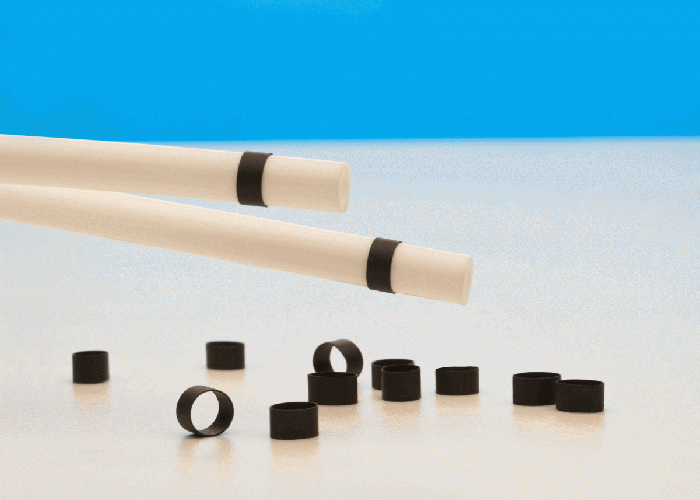Tungsten-filled plastic replaces gold as catheter marker
Putnam Plastics Corp. (Dayville, CT), which focuses on advanced extrusion for minimally invasive medical devices, is introducing a line of tungsten-filled polymer marker bands for fluoroscopic illumination of catheter tips. The goal is to reduce costs through elimination of the gold or platinum marker bands typically
June 22, 2012
Putnam Plastics Corp. (Dayville, CT), which focuses on advanced extrusion for minimally invasive medical devices, is introducing a line of tungsten-filled polymer marker bands for fluoroscopic illumination of catheter tips. The goal is to reduce costs through elimination of the gold or platinum marker bands typically
|
Matrix resin in the markers matches the shaft material. Photo: Putnam Plastics |
used. According to Putnam, the market bands also offer greater adhesion to catheter shaft tips.
The purpose of the short, thin-wall tubes made from gold or platinum placed on the tip of a catheter shaft is to provide radiopacity, or a high level of visibility under fluoroscopy. That's important because it allows surgeons to precisely locate the catheter features deep within the body for deployment of balloons, stents, and other devices in blood vessels.
A multi-step forming process is required to create seamless small diameter tubes from metals. Specialized manufacturing equipment crimps or swages metal bands to the polymer shaft tip so that they do not fall off during the medical procedure. It's a costly and time-consuming process. Quality controls to ensure sufficient mechanical bonding between these dissimilar materials can be significant.
Putnam's new marker bands are made from tungsten-filled polymers, such as nylons, urethanes and thermoplastic elastomers. Tungsten loadings range from 65% to 80% by weight to meet radiopacity requirements. Bands are customized using the same polymer specified for the catheter shaft to allow heat bonding of the band for a more secure assembly. Using proprietary co-extrusion technology, Putnam applies an unfilled polymeric outer surface to these bands similar to the surface of the catheter shaft to ensure minimal trauma to blood vessel walls.
Putnam Plastics offers polymer marker bands with inside diameters ranging from 0.014 inches (0.356mm) to 0.200 inches (5.080mm) and wall thicknesses ranging from 0.002 inches (0.051mm) to 0.030 inches (0.762mm).
"Our thermoplastic composite bands are cut from tubes extruded in a single process, which can provide cost savings and shorten lead times," said Ray Rilling, general manager at Putnam. "Plus, our bands offer outstanding radiopacity and can be thermally bonded to shafts for greater quality assurance."
Use of tungsten in plastics dates back several years when efforts accelerated to replace lead for radiation-shielding applications. One of the leaders in the field was compounder LNP of Exton, PA, which is now part of Sabic Innovative Plastics.
About the Author(s)
You May Also Like



